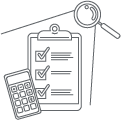Without doubt, the most common question an accountant is asked: “why does my profit not equal the cash in my bank account?”.
It is not uncommon that business owners do not understand this concept. This question can be answered by utilising budget and cashflow forecast modelling as a smarter approach to plan ahead, to avoid asking yourself this question altogether.
Taking it back to basics, the fundamentals of business management will help you understand the concept that profit and cash are not the same, so that when someone says “Show me the money!”, you are equipped with the answers.
that when someone says “Show me the money!”, you are equipped with the answers.
Back to Basics
Profits vs Cash
What is cash? Plain and simple, it is the money in your bank account. This number is represented on your balance sheet.
What is profit? It is a mathematical equation which represents what is left over after sales less business costs, such as stock purchased which has been sold, wages, rent and other operating expenses. This is summarised for a period in a profit and loss statement.
Both of these numbers are represented on a different statement of the financial statements and by understanding the relationship between the two statements, will help you understand why they are different.  Financial statements are prepared on an accrual basis, which means that sales and expenses are recorded when they are earned and incurred respectively. This means that income is earnt and recorded when an invoice is sent out not when the money has been received. An easy example of this is PBS claims - when a claim is put through, this is recorded as income even though the money will not be deposited into your bank until a few days later. At the same time, money could be spent on stock which is not considered an expense until the stock is sold. From this example, you can see how inextricably these two statements are linked and that at a point in time, the business could be showing a profit, but no cash in the bank.
Financial statements are prepared on an accrual basis, which means that sales and expenses are recorded when they are earned and incurred respectively. This means that income is earnt and recorded when an invoice is sent out not when the money has been received. An easy example of this is PBS claims - when a claim is put through, this is recorded as income even though the money will not be deposited into your bank until a few days later. At the same time, money could be spent on stock which is not considered an expense until the stock is sold. From this example, you can see how inextricably these two statements are linked and that at a point in time, the business could be showing a profit, but no cash in the bank.
Business Management with Cashflow Statement
What is a cashflow statement?
To better understand the balance in your bank account, a cashflow statement is a management tool that should be utilised. It summaries all the inflows and outflows of cash and shows where you have spent your money during a period of time. Positive net cashflow means there is more cash inflows than outflows, while a negative position means you are spending more than what you are collecting, and it also doesn’t necessarily mean you made a loss in the year. The easiest way to see this is with an example -
Net Profit |
150,000 |
Increase in stock on hand |
(20,000) |
Decrease in creditors (Current Year vs Previous year) |
(10,000) |
Purchase new security system |
(15,000) |
Reduce bank debt |
(50,000) |
Pay income tax |
(45,000) |
Take home drawings |
(100,000) |
Net Cashflow deficit |
(90,000) |

The above shows that although profits were good there was a lot of expenditure in the year that is not represented in the net profit and instead are outflows that affect the balance sheet. This example shows that cash was spent on stock, paying suppliers, purchasing equipment, paying down debt and taxes as well as your take-home drawings. All of which was in excess of the profits that you made in the year.
In addition, you need to consider your bank balance at the beginning of the year, to understand if this deficient of $90,000 is a problem. For example, if you had $200,000 in the bank account, then the cash balance would remain in a surplus of $110,000. However, it wasn’t and the result of the $90,000 continued to put your bank balance in a deficient. You need to monitor this closely and act quickly.
Act now and be informed
Poor business management of cashflow is one of the top reasons for business failure. Having that basic understanding of what your financial statements are saying enables you to have a better idea of how to tackle this question and be an informed business owner. However, your cashflow statement and your cashflow should be monitored regularly and not just as a once a year exercise if you want to run a successful business. An accountant or business advisor can assist you with this and with cloud accounting and technology a cashflow statement or forecast can be easily prepared.
 Tips to improve and manage your cashflow
Tips to improve and manage your cashflow
- Improve business profits – improve sales and margin or better manage your expenses. Are you getting all the professional services income you can get? Whilst profit does not equal cash, to generate cash, you need to be maximising profits in the first place.
Review your debtors and ensure you collect your money within a timely manner. Consider providing a discount for early payments. - Review your supplier trading terms - see if you can increase your trading terms to delay payment
- Can you renegotiate your bank loan reduction terms – to interest-only terms if necessary?
- Plan when your income tax is due and make sure you have the funds put aside for this before you spend it on something else
- Funding for new plant & equipment – instead of using the cash in your bank account to purchase new equipment, could you fund it otherwise with a chattel mortgage or consider leasing the equipment instead of owning it outright and using up your cash reserves?
- Lastly, can you take less money out of the business?
If you need further assistance regarding any of the content discussed in this article, get in contact with your local RSM Pharmacy Business Expert >>.
This article was originally published in Gold Cross Products & Services Pty Ltd • ITK Issue 68 • October-November 2019
